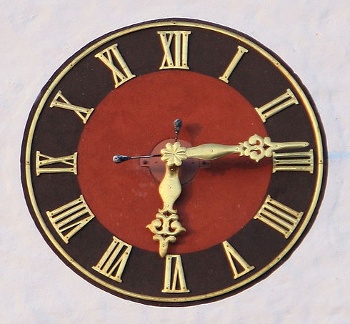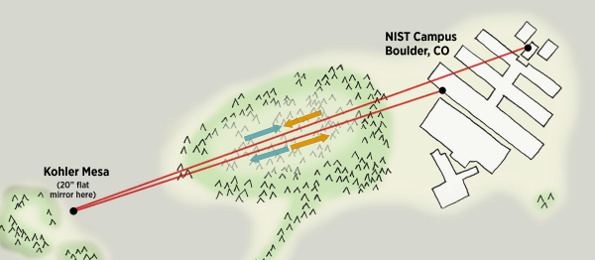Does Anybody Really Know What Time It Is?
June 7, 2013
There are
laboratories with
atomic clocks capable of keeping time to a
precision of one
part in 10
14, for an
accuracy of about one
second in a billion
years. Not many people need such accuracy. When I ask for the time, "about three o'clock" is often good enough for me.
As I was growing up, there were evolving ways of getting time to the people. The
telephone company had a calling number you could
dial to hear the spoken time, as did a local
bank, which provided the
temperature as well.
Radio stations were a good source of time information, and they usually subscribed to a
time service that
synchronized their
mechanical clocks by an
electric pulse distributed each hour via
telephone lines.

Clock of the Church of Saint Martin, Busskirch, Jona, Switzerland
Clock faces use IIII as the Roman numeral for the number four, and not IV.
This was actually the preferred way to write four through most of history.
(Photo by Roland zh, via Wikimedia Commons.)
As a
tween technology enthusiast of
my generation, I had a
shortwave radio, and I was able to receive the time signal radio broadcasts from the
National Bureau of Standards (now
National Institute of Standards and Technology, NIST) time station,
WWV, on 5 MHz. The "tick-tock" signal of WWV was often too weak, so I would opt for the "beep-beep" signal of
Canada's time station,
CHU, operated by the
National Research Council, at 3.330 MHz.
The
speed of light is an important factor in reception of time signals, but direct reception of a
radio signal from a thousand
miles away results in just a five
millisecond delay, which wasn't too important half a
century ago. The speed of light in a
wire, however, is smaller, and when you put
amplifiers and
loading coils in the path, delays start to add up.
I observed the delay effect of wire transmission first hand in the late 1960s while working at a radio station. In what was a good simulation of
Internet radio, the
engineers on our
network news feed, which originated from
Chicago, were using the off-air signal of Chicago radio station,
WCFL, as a test signal. I could hear a considerable delay between the broadcast signal, received on an
AM radio, and the signal on the network feed.
My wife had an
Atomic Watch; or, at least, that's what her colleagues called it. It was one of the first
digital wrist watches. Since it had a power-hungry
LED display, you needed to push a button to see the time, which was in hours and minutes, only. We went through a lot of watch
batteries, which were not that common at the time, since her colleagues were always asking her for the time.
Nowadays, we can use the
Global Positioning System as our time reference, by which we can easily get a tenth of a
microsecond accuracy. The traditional time stations have tried to keep pace with the
digital world, with WWV providing a digital time code in
BCD format on a 100
Hz subcarrier; and CHU providing digital signals in the more computer compatible
Bell 103, 300 baud format. The Bell 103 format was used by early telephone
modems and is used in the US
caller-ID system.
One problem that the legacy time signal stations have is the same problem
television broadcasters had many years ago when they wanted to broadcast
color video and still have their signals remain compatible with the older
monochrome television receivers. NIST has recently upgraded the WWV signal by adding a
phase modulated signal.[1] This signal supplements the
amplitude modulated signal of the
carrier wave, it allows better signal reception on newer devices, but it allows older devices to function as before.
NIST
scientists have just demonstrated accurate time signal synchronization between distant locations using
free-space optical communication. The reason for going optical is simple. You can't use
microwave radio signals to achieve the
femtosecond accuracy inherent in the present generation of atomic clocks. You need a higher carrier
frequency to get that resolution.[2-3]
Such a free-space optical connection, implemented using
lasers, has application in improved
geodesy on the ground, and for
satellite-based
relativity experiments in
space.[2] The demonstration was conducted using
eye-safe,
infrared laser pulses
reflected from a
mirror on a hillside, as shown in the figure.

Ultraprecise time signals were transferred on an infrared laser beam by NIST researchers between a laboratory on NIST's campus in Boulder, Colorado, and nearby Kohler Mesa. Signals from the laboratory were reflected off a mirror on the mesa, and returned approximately two kilometers to the laboratory. The two-way technique overcomes timing distortions from atmospheric turbulence. (Talbott/NIST image.)[3)]
Synchronization of
oscillators at each end of the path was by
phase-locking to a
coherent frequency comb carried on the laser beam. The frequency comb was a stream of ultrashort optical pulses, the spacing of which was synchronized precisely with a
resonant optical cavity that served as a stand-in for an atomic clock.
The measured timing difference between the two path ends was infinitesimal, just one million-billionths (10
-15) of a second per hour.[3] This femtosecond precision was obtained despite signal fading from atmospheric turbulence and obstructions across the two kilometer optical link.[2] This research was funded in part by the
Defense Advanced Research Projects Agency (DARPA).[3]
Does Anybody Really Know What Time It Is? is a 1969 song by the music group,
Chicago. The group was originally called The Chicago Transit Authority, until the
actual transit authority objected. Apparently, the
Windy City posed no objection to the use of its
Chicago name.
References:
- James Burrus, "New NIST time code to boost reception for radio-controlled clocks," NIST Tech Beat, National Institute of Standards and Technology, March 5, 2013
- Fabrizio R. Giorgetta, William C. Swann, Laura C. Sinclair, Esther Baumann, Ian Coddington and Nathan R. Newbury, "Optical two-way time and frequency transfer over free space," Nature Photonics, Online Before Print, April 28, 2013, doi:10.1038/nphoton.2013.69.
- Laura Ost, "NIST Demonstrates Transfer of Ultraprecise Time Signals over a Wireless Optical Channel, NIST Tech Beat, National Institute of Standards and Technology, April 30, 2013.
- NIST Physical Measurement Laboratory, Time and Frequency Division , Time and Frequency Services Web Site.
Permanent Link to this article
Linked Keywords: Laboratory; atomic clock; precision; parts-per notation; accuracy; second; year; Bell System; telephone company; rotary dial; dial; bank; temperature; radio broadcasting; radio station; time service; synchronization; synchronized; mechanical clock; electric pulse; telephone line; Church of Saint Martin, Busskirch; Jona; Switzerland; Roman numeral; Wikimedia Commons; preadolescence; tween; technology; nerd; enthusiast; baby boomer; shortwave radio; National Bureau of Standards; National Institute of Standards and Technology; NIST; WWV radio station; Canada; CHU radio station; National Research Council; speed of light; radio signal; mile; millisecond; century; wire; amplifier; loading coil; Internet radio; broadcast engineer; United States radio networks; network news feed; Chicago; WCFL; AM broadcasting; AM radio; digital wrist watch; LED display; battery; Global Positioning System; microsecond; digital world; binary-coded decimal; BCD format; hertz; Hz; subcarrier; Bell 103; 300 baud; modem; caller-ID system; television broadcasting; color; video; monochrome; television set; television receiver; phase modulation; phase modulated; amplitude modulation; amplitude modulated; carrier wave; scientist; free-space optical communication; microwave; femtosecond; frequency; laser; geodesy; satellite; theory of relativity; experiment; outer space; laser safety; eye-safe; infrared; reflection; mirror; Boulder, Colorado; mesa; kilometer; atmospheric turbulence; oscillation; oscillator; phase-locked loop; phase-locking; coherence; coherent; frequency comb; resonance; resonant; optical cavity; DARPA; Defense Advanced Research Projects Agency; Does Anybody Really Know What Time It Is?; Chicago; Chicago Transit Authority; Windy City; Chicago.